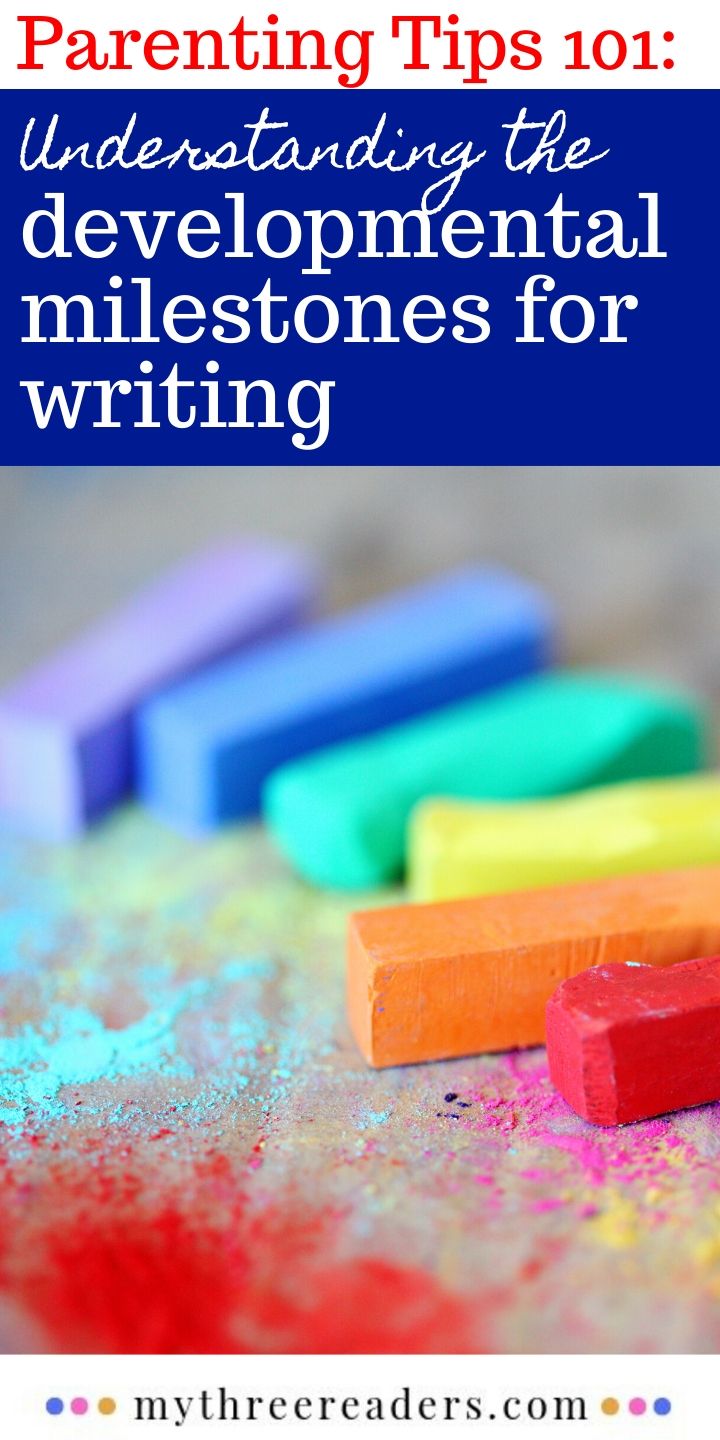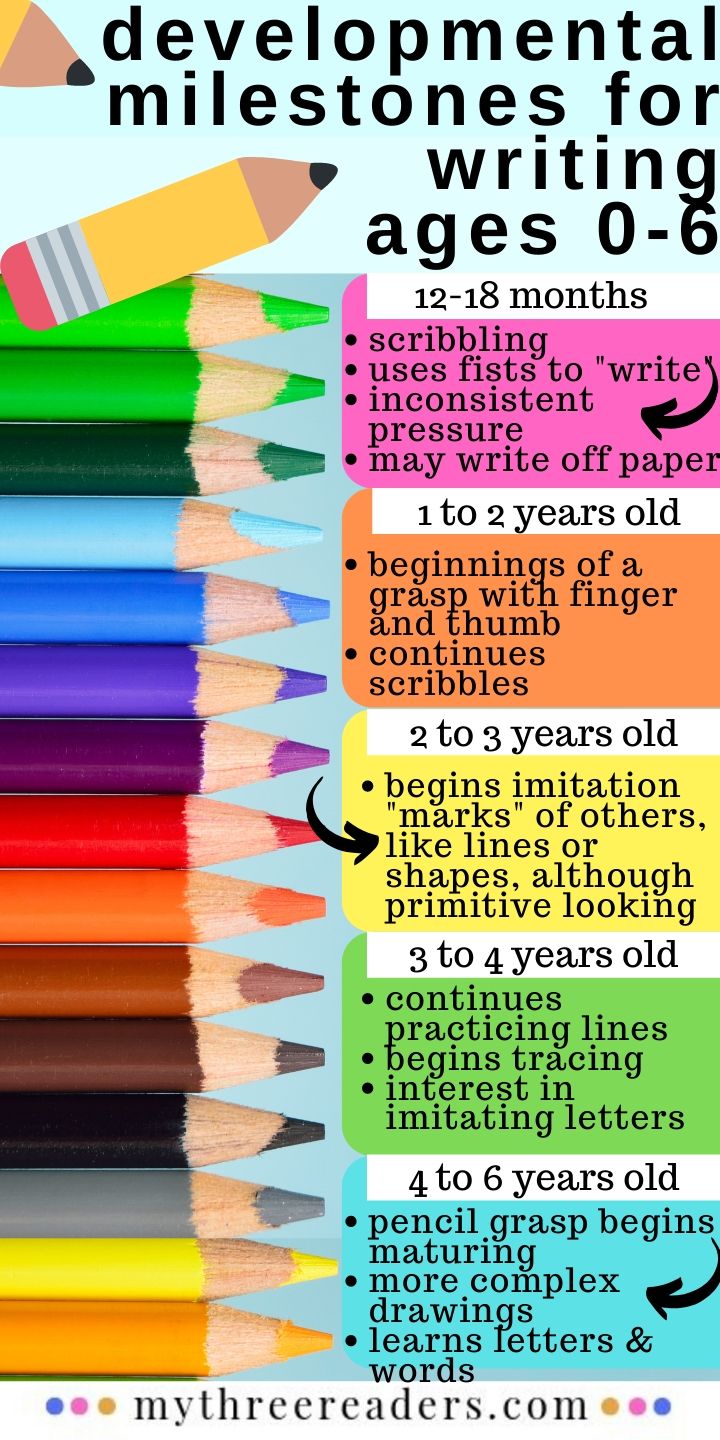The Developmental Milestones for Writing
Are you teaching or parenting a young learner? You may be interested to know what exactly the developmental milestones are for writing as your young one grows.
A brief overview of the developmental milestones for writing:
- 12-18 months - scribbling, uses fists to "write", inconsistent pressure, may write off paper
- 1 to 2 years old - beginnings of a grasp with finger and thumb, continues scribbles
- 2 to 3 years old - begins imitation "marks" of others, like lines or shapes, although primitive looking
- 3 to 4 years old - continues practicing lines, begins tracing, interest in imitating letters
- 4 to 6 years old - pencil grasp begins maturing, more complex drawings, learns letters & words
Make sure to closely observe how your child is doing compared to what is generally "normal" at certain ages. And while you do so, remember to keep in mind that children develop skills at different rates, so keep these in mind, but don't push your child in an area he or she might not be ready for yet.
Today My Three Readers brings you some great information on some of the basics of the developmental stages of print guest posted by Alesia Netuk of PrimaryLearning.org.
PrimaryLearning.org provides primary school educational resources for teachers and parents including worksheets, printable workbooks, lesson plans, hands-on activities and the most up-to-date educational articles.
As an Amazon Associate I earn from qualifying purchases. You can learn more about that here.
Learning to print or write letters is a complex process drawing on many skills including hand-eye coordination, muscle memory, and body control.
It is for this reason that forming letters correctly does not typically begin until around age four to six. Before this developmental stage, there are many other ways that toddlers begin to explore writing.
Writing development 12-18 months old
Around 12 to 18 months, toddlers may “write” by scribbling. Their pencil grasp is not yet developed and they often hold writing utensils in their fists.
They may use inconsistent degrees of pressure on their writing tools as they make marks on paper.
It’s also common for toddlers to go beyond the edges of the paper when they’re scribbling and write on surfaces like tables.

Pencil grasp development
The next developmental stage occurs around age 12 months to two years. Children may start to incorporate their fingers and thumb into their pencil grasp, but still not hold writing tools effectively.
They may have more success staying on the paper when “writing,” as long as it’s a larger than typical size. Scribbling and random marks on the paper are still common at this age.
Around age two to three, children are typically still developing an effective pencil grasp. Instead of relying on scribbling, they may start to imitate marks and shapes they see others making.
For example, children at this age may begin making lines with their writing tool or shapes such as a circle. They still demonstrate a lack of control using their writing utensil so shapes appear primitive.
Check out the bundle below to help your child practice the alphabet! You can also practice with these FREE Alphabet pages from A to Z

Pre writing strokes progression
Imitation may continue around age three to four. Children may experiment with making vertical, horizontal, and curved lines, as well as shapes.
They may attempt to trace simple lines and shapes made by others. You may also see children showing an interest in writing letters. They also may imitate “writing” by making sequences of lines and curves meant to represent letters.
Toward the end of this stage, begin demonstrating a more effective, emerging pencil grasp.
4 to 6 year old writing ability
Around age four to six, many children will develop a mature, efficient pencil grasp that continues into adulthood.
Their drawings move beyond lines and shapes and develop more complexity. They may experiment with simple drawings of things like people, cars, and houses.
These drawings require planning, which children at this stage are now capable of performing. Their pictures have meaning that they can describe for you.
During this stage, children are also starting to become more proficient with staying inside the lines when coloring. Also, children may become more skilled at copying writing that is modeled by someone else.
It is during this four to six year old stage that children typically begin printing the letters of the alphabet.
In order to develop proficiency with printing, children need to be exposed to models of accurate letter formations.
They have a growing awareness that when grouped together, letters create words. One of the first words children often print is their name.
To teach and encourage printing, children need to see the letters, have opportunities to trace them, and then participate in independent practice.
The handwriting worksheets found at Primary Learning give step-by-step instructions to print letters correctly. You can also find tracing worksheets like those found here to help ensure that when children are beginning to print, they learn the correct pathways for forming each letter.
When children move from printing letters to writing them in cursive, they again need a visual model of each letter. It is also important that they learn the correct pathways to write letters.
Cursive worksheets like those found on Primary Learning provide these visual models and group together letters with similar pathways.
For more information about writing and worksheets that can help with writing practice, be sure to visit Alesia at Primary Learning!

Stages of writing development chart
Hopefully, this will give you some idea of what to expect as your child grows into a developing writer.
You can also use the chart below to keep handy as you consider where your child is in the developmental process of writing:





